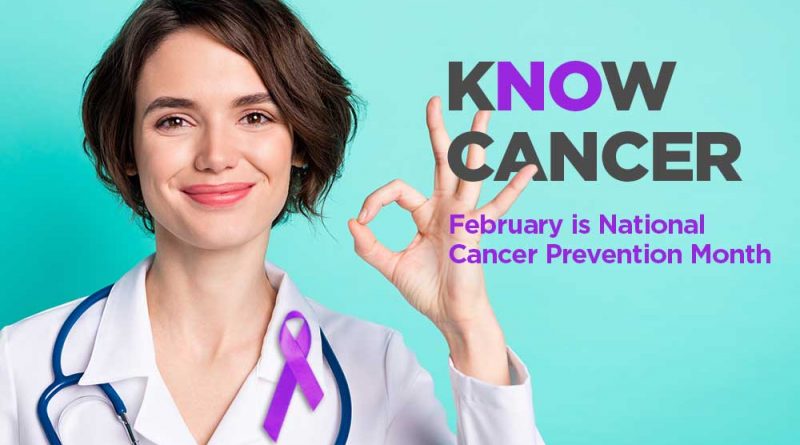National Cancer Prevention Month: What You Should Know
At some point, everyone has known someone who has had cancer. In 2020, the National Cancer Institute estimated that close to 1.8 million new cases of cancer are diagnosed each year in the United States. Of those diagnosed, close to 600,000 will die from the disease.
February is National Cancer Prevention Month and serves as a reminder to everyone to take available precautions to detect cancer.
Early Detection and Screenings
Early detection of many types of cancer can be caught before they spread to other parts of the body, increasing their survival rate. To ensure maximum early detection, one should undergo routine screenings as recommended by their doctor. Almost every kind of cancer has a screening test available to allow for early detection. Depending on a person’s age, family history and prior medical issues, their doctor will recommend at what point they should have these screenings done.
According to the Centers for Disease Control and Prevention (CDC), here are some of the most common screening tests important for people to be aware of:
Breast Cancer Screening
- Mammograms: Women ages 40 to 75 should get a mammogram every one or two years to detect early signs of breast cancer.
- Breast Magnetic Resonance Imaging (MRI): A breast MRI uses magnets and radio waves to take pictures of the breast. Specifically, this type of screening is for women who are at high risk of getting breast cancer.
- Breast Self-Exams: For these exams, one can do daily checks on their own breasts. Any lumps, pain or changes in the size of a growth may be cause for concern. You should also make sure to report any changes you notice to your doctor or other healthcare providers.
- Clinical Breast Exam: This exam is usually conducted by a doctor or nurse, using their hands to feel for lumps or other changes in growths.
Lung Cancer Screening
- Low-dose Computed Tomography (CT): Screening for Lung Cancer is recommended for adults ages 50 to 80 years old who currently smoke, have quit smoking within the past 15 years and/or have a past history of smoking 20 or more packs per year.
Colon Cancer Screening
- Colorectal Screening: Adults ages 45 to 75 should get a colorectal screening for colon cancer approximately every 10 years.
Cervical Cancer Screening
- HPV Test: This test looks for the HPV virus (human papillomavirus) which can cause cell changes in the cervix.
- Pap Smear: Doctors encourage women ages 21 to 65 to get screenings for cervical cancer via a Pap smear every 2-3 years.
Keep in mind, even though it is crucial to do routine screenings if you are in the target age range, these tests can occasionally show false positive test results. In some cases, this may also involve additional testing.
Ways to Reduce Your Risk of Cancer
In addition to screenings, there are many other preventative actions one can take to lower their chances of getting cancer. Increasing physical activity, as well as eating and living a healthier lifestyle, are easy ways to help prevent many diseases. Other actions to help in this effort could include:
- Eat a diet rich in whole grains, as well as vegetables, fruits and beans
- Limit alcohol consumption
- Stop smoking
- Limit consumption of sugar-sweetened drinks
- Get vaccines on a regular basis as directed
- Limit UV-ray exposure
- Manage your weight
Grants for Cancer Research
Daily cancer research discoveries are being made. As a result, there are approximately 18 million people who continue to survive and even overcome many cancer afflictions. Providing more funding to researchers and institutions for cancer research is essential to aid this effort. GrantWatch.com has many grants listed for cancer research and treatment. Below are 10 of these grants currently accepting applications:
- Grants are available to eligible scientists and doctors affiliated with institutions for breast cancer research.
- There are also grants available to nonprofits and individuals to research the impact of changes in healthcare systems, with a focus on cancer prevention, control and treatment.
- Grants of up to $10,000 are also available to nonprofits for projects addressing reconstructive surgery for breast cancer patients.
- Up to $50,000 is available to research institution investigators to improve the quality of life for cancer patients and survivors.
- Additionally, grants are available to scientists and doctors working in nonprofit academic institutions for cancer research projects.
- Researchers at nonprofit institutions and organizations can also apply for grants to research cures and treatments for childhood cancers.
- Fellowships are also available to graduate students and recent Ph.D. graduates in postdoctoral positions for pancreatic cancer research
- In addition, fellowships are available to researchers at universities, hospitals and institutions for projects related to the study of cancer.
- Grants are also available to academic research institution investigators related to prostate cancer.
- Finally, grants are available to early-career scientists to support research and career development. Funding is for applicants who have made important advances in the fields of brain cancer and brain tumor research.
GrantNews Notes
Are you looking for more grants like the ones on this list? GrantWatch also features an entire category for health and medical grants on its site.
With close to 8,000 grants currently available, GrantWatch.com is the leading grant listing directory. A MemberPlus subscription is required to view the full grant details, including the eligibility criteria and application information. For more information, you can also visit the GrantWatch FAQ page.

